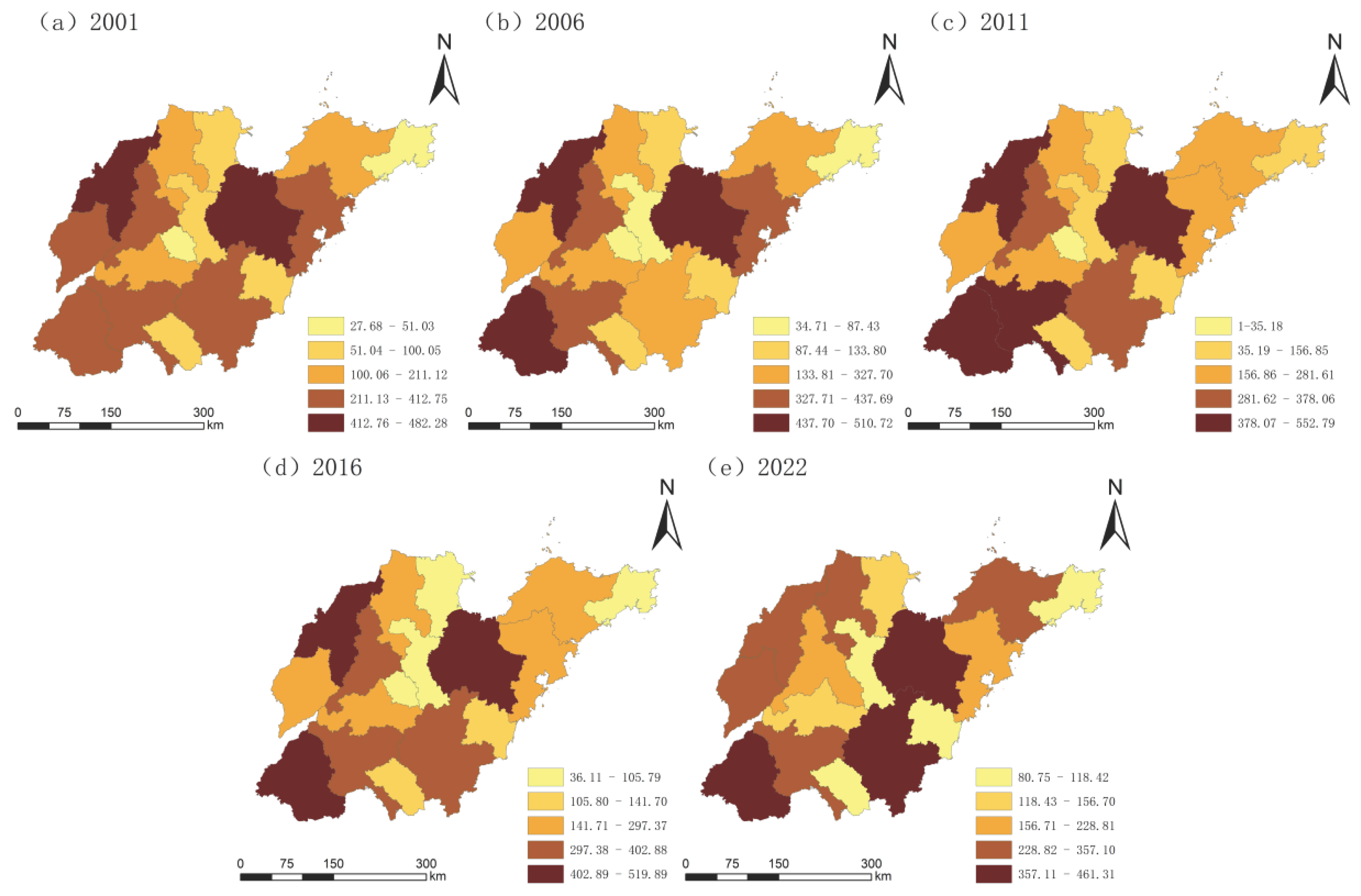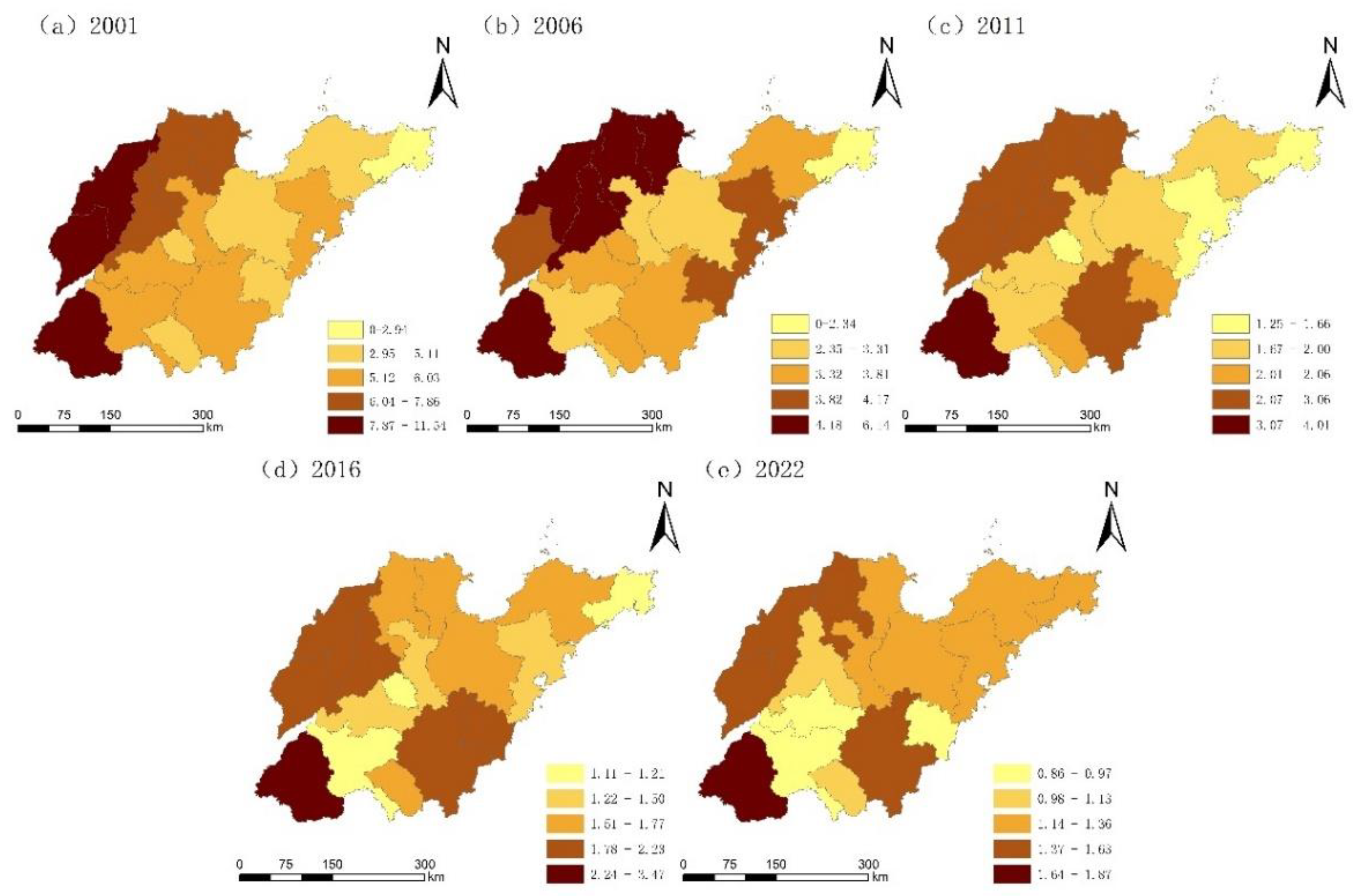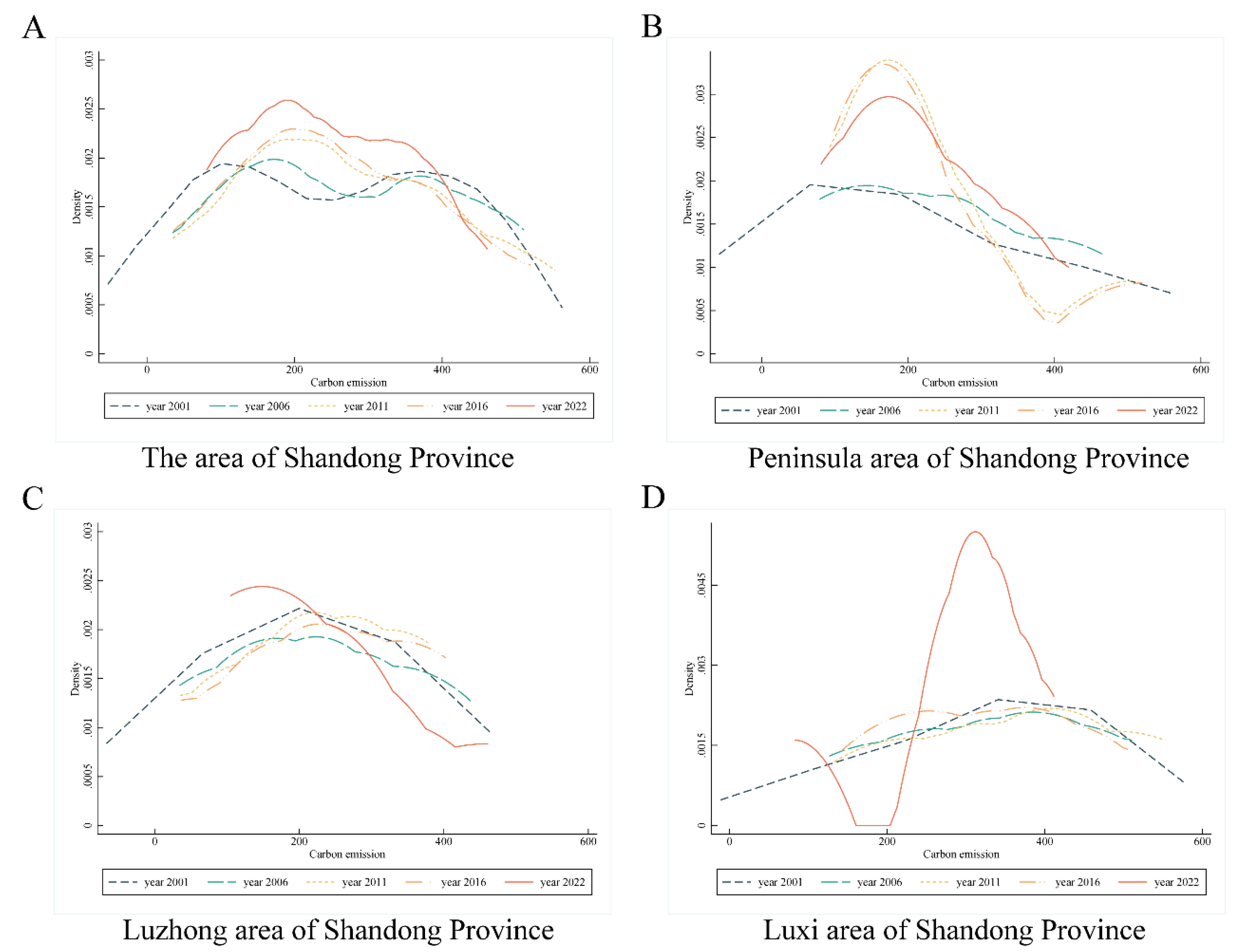Submitted:
27 February 2024
Posted:
28 February 2024
You are already at the latest version
Abstract
Keywords:
1. Introduction
2. Materials and Methods
2.1. Calculation of Animal Husbandry Carbon Emissions
| Species | CH4[kg/(head. a)] | N2O [kg/(head. a)] | Reference Source | |
|---|---|---|---|---|
| Gastrointestinal fermentation | Manure management | |||
| Cattle | 52.90 | 3.31 | 0.85 | Zheng et al., (2022) [19] |
| Mule | 10.00 | 0.90 | 1.39 | Yao et al., (2017) [11] |
| Donkey | 10.00 | 0.90 | 1.39 | |
| Horse | 18.00 | 1.64 | 1.39 | |
| Pig | 1.00 | 3.50 | 0.53 | |
| Sheep | 5.00 | 0.16 | 0.33 | |
| Rabbit | 0.254 | 0.08 | 0.02 | |
| Poultry | 0.00 | 0.02 | 0.02 | |
2.1.1. Feed Grain Input System
2.1.2. Energy Consumption System
2.1.3. Gastrointestinal Fermentation and Feces Management System
2.1.4. Total Animal Husbandry Carbon Emissions
2.2. Kernel Density Estimation
2.3. Data Sources
3. Results
3.1. Total Carbon Emissions and Spatial Distribution of Animal Husbandry in Shandong Province
3.2. Carbon Emission Intensity and Spatial Distribution of Animal Husbandry in Shandong Province
3.3. Kernel Density Estimation of Animal Husbandry Carbon Emissions
4. Conclusions and Policy Recommendations
4.1. Conclusion
4.2. Policy Proposal
Author Contributions
Funding
Institutional Review Board Statement
Informed Consent Statement
Data Availability Statement
Acknowledgments
Conflicts of Interest
References
- Fan, H.; Chen, K.; Ma, H.; He, J.; Li, H.; Yang, Z.; Wu, Q.; Zhang, C.; Zhang, S.; Huang, T.; Gao, H. Carbon footprints in pork production and consumption in China from 2005 to 2020. J. Clean. Prod. 2023, 419, 138252. [Google Scholar] [CrossRef]
- EDGAR - Emissions Database for Global Atmospheric Research. Available online: https://edgar.jrc.ec.europa.eu/report_2023 (accessed on 19 December 2023).
- Steinfeld, H.; Gerber, P.J.; Wassenaar, T.; Castel, V.; Rosales, M.; De Haan, C. Livestock’s Long Shadow: Environmental Issues and Options; FAO: Rome, Italy, 2006. [Google Scholar]
- Huo, L.; Yao, Z.; Zhao, L.; Luo, J.; Zhang, P. Current status and system construction of emission reduction and carbon sequestration standards in China's agriculture and rural areas. Trans. Chin. Soc. Agric. Env. Sci. 2023, 42, 242–251. [Google Scholar] [CrossRef]
- Zhuang, M.; Lu, X.; Caro, D.; Gao, J.; Zhang, J.; Cullen, B.; Li, Q. Emissions of non-CO2 greenhouse gases from livestock in China during 2000–2015: Magnitude, trends and spatiotemporal patterns. J Environ Manage. 2019, 242, 40–45. [Google Scholar] [CrossRef] [PubMed]
- Gao, Z.; Lin, Z.; Yang, Y.; Ma, W.; Liao, W.; Li, J.; Cao, Y.; Roelcke, M. Greenhouse gas emissions from the enteric fermentation and manure storage of dairy and beef cattle in China during 1961–2010. Environ Res. 2014, 135, 111–119. [Google Scholar] [CrossRef]
- Rehman, A.; Ma, H.; Ozturk, I.; Ahmad, M. Examining the carbon emissions and climate impacts on main agricultural crops production and land use: updated evidence from Pakistan. Environ Sci Pollut Res Int. 2022, 29, 868–882. [Google Scholar] [CrossRef]
- Cheng, M.; Yao, W. Trend prediction of carbon peak in China's animal husbandry based on the empirical analysis of 31 provinces in China. Environ. Dev. Sustain. 2022, 1–18. [Google Scholar] [CrossRef]
- Weiss, F.; Leip, A. Greenhouse gas emissions from the EU livestock sector: a life cycle assessment carried out with the CAPRI model. Agric Ecosyst Environ. 2012, 149, 124–134. [Google Scholar] [CrossRef]
- Xu, J.; Wang, J.; Wang, T.; Li, C. Impact of industrial agglomeration on carbon emissions from dairy farming—Empirical analysis based on life cycle assessmsent method and spatial durbin model. J. Clean. Prod. 2023, 406, 137081. [Google Scholar] [CrossRef]
- Yao, C.; Qian, S.; Mao, Y.; Li, Z. Decomposition of impacting factors of animal husbandry carbon emissions change and its spatial differences in China. Transac Chin Soc Agri Eng. 2017, 33, 10–9. [Google Scholar] [CrossRef]
- Xue, Y.; Luan, W.; Wang, H.; Yang, Y. Environmental and economic benefits of carbon emission reduction in animal husbandry via the circular economy: case study of pig farming in Liaoning, China. J. Clean. Prod. 2019, 238, 117968. [Google Scholar] [CrossRef]
- Dai, X.; Sun, Z.; Muller, D. Driving factors of direct greenhouse gas emissions from China’s pig industry from 1976 to 2016. J. Integr. Agric. 2021, 20, 319–329. [Google Scholar] [CrossRef]
- Cai, T.; Xia, F.; Yang, D.; Huo, J.; Zhang, Y. Decomposition of factors affecting changes in non-CO2 greenhouse gas emission intensity of China's livestock sector based on the concept of “environment–food–economy”. Sci. Total Environ. 2019, 691, 611–620. [Google Scholar] [CrossRef]
- Hao, D.; Wang, R.; Gao, C.; Song, X.; Liu, W.; Hu, G. Spatial-Temporal Characteristics and Influence Factors of Carbon Emission from Livestock Industry in China. Int. J. Environ. Res. Public Health. 2022, 19, 14837. [Google Scholar] [CrossRef]
- Shi, R.; Irfan, M.; Liu, G.; Yang, X.; Su, X. Analysis of the impact of livestock structure on carbon emissions of animal husbandry:A sustainable way to improving public health and green environment. Front. Public Health. 2022, 10, 835210. [Google Scholar] [CrossRef] [PubMed]
- Dai, X.; Li, J.; He, Y.; Wang, F. Regional equity and efficiency of carbon emissions of China's livestock industry in 2000-2020. Resources Science, 2023, 45, 62–76. [Google Scholar] [CrossRef]
- Raghavendra, B.; Malik, P.; Prasad, C. Enteric methane emission: status, mitigation and future challenges-an Indian perspective//Livestock production and climate change; CABI: Wallingford, UK, 2015; pp. 229–244. [Google Scholar] [CrossRef]
- Zheng, B.; Liang, H.; Wan, W.; Liu, Z.; Zhu, J.; Wu, Z. Spatial-temporal pattern and influencing factors of agricultural carbon emissions at the county level in Jiangxi Province of China. Trans. Chin. Soc. of Agric. Eng. 2022, 38, 70–80. [Google Scholar]
- Xie, H.; Chen, X.; Yang, M.; Zhao, H.; Zhao, M. Ecological footprint analysis of livestock products in China. Acta. Ecol. Sin. 2009, 29, 3264–3270. [Google Scholar]
- Tan, Q. Greenhouse gas emission in China's agriculture: situation and challenge. China Popul. Resour. Environ. 2011, 21, 69–75. [Google Scholar]
- Meng, X.; Cheng, G.; Zhang, J.; Wang, N.; Zhou, H. Spatial and temporal characterization of greenhouse gas emissions over the whole life cycle of animal husbandry in China. China Environ. Sci. 2014, 34, 2167–2176. [Google Scholar]
- Sun, Y.; Liu, J.; Ma, Z. Evaluation of greenhouse gas emissions from scale dairy farm1. Trans. Chin. Soc. Agric. Eng. 2010, 26, 296–301. [Google Scholar]
- Li, Y.; Wang, J.; Yang, L. Spatial and temporal characterization of agricultural carbon emissions in Hunan Province based on county scale. China Agric. Resour. Zoning 2022, 43, 75–84. [Google Scholar]
- Zhu, Z.; Wang, Y.; Yan, T.; Zhang, Z.; Wang, S.; Dong, H. Greenhouse gas emissions from livestock in China and mitigation options within the context of carbon neutrality. Front Agric Sci Eng. 2023, 0. [Google Scholar] [CrossRef]
- Misselbrook, T.; Webb, J.; Chadwick, D.; Ellis, S.; Pain, B. Gaseous emissions from outdoor concrete yards used by livestock. Atmos. Env. 2001, 35, 5331–5338. [Google Scholar] [CrossRef]
- Wang, Z.; Kong, F.; Pan, D. Analysis of spatial and temporal differences in greenhouse gas emissions from livestock industry in Jiangxi Province - Based on LCA method. J. Poyang Lake 2015, (03), 26–36. [Google Scholar]
- Chen, D.; Li, Y.; Grace, P.; Mosier, A. N2O emissions from agricultural lands: a synthesis of simulation approaches. Plant Soil 2008, 309, 169–189. [Google Scholar] [CrossRef]
- Hallin, S.; Philippot, L.; Löffler, F.; Sanford, R.; Jones, C. Genomics and ecology of novel N2O-reducing microorganisms. Trends Microbiol. 2018, 26, 43–55. [Google Scholar] [CrossRef]
- Liu, D.; Zhu, X.; Wang, Y. China's agricultural green total factor productivity based on carbon emission: an analysis of evolution trend and influencing factors. J. Clean. Prod. 2021, 278, 123692. [Google Scholar] [CrossRef]
- Cui, K. Research on the Analysis of Rural Regional Economic Differences and Coordinated Development in Shandong Province. Master’s thesis, Shandong University of Technology, Shandong, China, 2023. [Google Scholar]
- Zhao, B. Research on carbon emission measurement and spatial-temporal evolution in Henan Province. Master’s thesis, Henan University, Henan, China, 2015. [Google Scholar]



| System | Link | Symbol | Emission coefficient | Values | Unit | Reference Source |
|---|---|---|---|---|---|---|
| Feed grain input | Feed grain cultivation | efj1 | CO2-Equivalent Emission Factor of Corne |
1.50 | t/t | Xie et al., (2009) [20] |
| CO2-Equivalent Emission Factor of Wheat |
1.22 | t/t | ||||
| Feed grain transport &processing | efj2 | CO2-Equivalent Emission Factor of Corn |
0.0102 | t/t | Tan et al., (2011) [21] | |
| CO2-Equivalent Emission Factor of Soybean |
0.1013 | t/t | ||||
| CO2-Equivalent Emission Factor of Wheat |
0.0319 | t/t | ||||
| Energy consumption | Livestock and poultry rearing | efe | CO2 Emission Factor of Electricity Consumption |
0.9734 | t/MW·h | Meng et al., (2014) [22] |
| Pricee | Breeding electricity unit price | 0.4275 | CNY/KW·h | |||
| efc | Coal combustion CO2 emission factor | 1.98 | t/t | Sun et al., (2010) [23] | ||
| Pricec | Unit price of coal | 800 | CNY/t | |||
| Livestock and poultry products processing | MJu | Energy consumption for processing pork products | 3.76 | MJ/kg | Meng et al., (2014) [22] | |
| Energy consumption for processing beef products | 4.37 | MJ/kg | ||||
| Energy consumption in the processing of mutton products | 10.4 | MJ/kg | ||||
| Energy consumption in the processing of poultry meat products | 2.59 | MJ/kg | ||||
| Energy consumption in the processing of milk products | 1.12 | MJ/kg | ||||
| Energy consumption in the processing of poultry and egg products | 8.16 | MJ/kg | ||||
| e | Electric heating value | 3.60 | MJ/KW·h | - |
| Region | Total animal husbandry carbon emissions (10kt/CO2-eq) | Rate of change (%) | ||||||||
|---|---|---|---|---|---|---|---|---|---|---|
| 2001 | 2003 | 2006 | 2009 | 2011 | 2013 | 2016 | 2019 | 2022 | ||
| Jinan | 372.15 | 435.12 | 437.69 | 323.89 | 329.12 | 340.47 | 318.54 | 241.91 | 191.26 | -0.49 |
| Qingdao | 399.50 | 437.44 | 429.86 | 257.95 | 259.05 | 257.11 | 234.45 | 228.05 | 228.81 | -0.43 |
| Zibo | 100.05 | 118.60 | 87.43 | 89.05 | 102.05 | 104.77 | 92.17 | 93.60 | 104.75 | 0.05 |
| Zaozhuang | 82.23 | 102.47 | 126.48 | 119.85 | 132.89 | 137.65 | 141.70 | 89.88 | 82.38 | 0.00 |
| Dongying | 89.77 | 111.55 | 133.80 | 135.64 | 156.85 | 161.34 | 105.79 | 127.68 | 156.70 | 0.75 |
| Yantai | 160.26 | 204.80 | 254.00 | 233.67 | 237.71 | 228.98 | 252.32 | 303.99 | 283.18 | 0.77 |
| Weifang | 454.12 | 485.58 | 466.93 | 456.45 | 508.91 | 522.66 | 519.89 | 433.79 | 419.36 | -0.08 |
| Jining | 371.98 | 446.89 | 407.11 | 414.81 | 448.56 | 460.02 | 337.34 | 304.18 | 282.09 | -0.24 |
| Tai'an | 211.12 | 265.40 | 228.72 | 236.14 | 266.15 | 286.25 | 285.55 | 187.38 | 150.20 | -0.29 |
| Weihai | 51.03 | 66.64 | 79.16 | 84.02 | 92.86 | 98.84 | 98.80 | 99.26 | 80.75 | 0.58 |
| Rizhao | 93.00 | 105.07 | 109.15 | 99.04 | 116.97 | 120.90 | 135.88 | 134.30 | 118.42 | 0.27 |
| Laiwu | 27.68 | 34.65 | 34.71 | 32.65 | 35.18 | 35.74 | 36.11 | - | - | - |
| Linyi | 319.58 | 352.55 | 327.70 | 348.47 | 378.06 | 382.99 | 402.88 | 418.07 | 461.31 | 0.44 |
| Dezhou | 482.28 | 565.03 | 510.72 | 511.05 | 552.79 | 599.16 | 507.62 | 461.83 | 357.10 | -0.26 |
| Liaocheng | 412.75 | 452.02 | 282.80 | 256.68 | 281.61 | 283.84 | 297.37 | 286.66 | 318.05 | -0.23 |
| Binzhou | 204.94 | 238.03 | 230.62 | 243.24 | 279.81 | 272.12 | 236.68 | 255.66 | 290.82 | 0.42 |
| Heze | 379.49 | 477.20 | 492.95 | 451.83 | 473.92 | 500.89 | 493.79 | 541.73 | 411.81 | 0.09 |
| Region | Carbon emission intensity of animal husbandry (tons/ten thousand yuan) | Rate of change(%) | ||||||||
|---|---|---|---|---|---|---|---|---|---|---|
| 2001 | 2003 | 2006 | 2009 | 2011 | 2013 | 2016 | 2019 | 2022 | ||
| Jinan | 7.27 | 7.14 | 5.16 | 3.21 | 2.42 | 2.18 | 1.91 | 1.67 | 1.12 | -0.85 |
| Qingdao | 5.27 | 5.09 | 3.99 | 2.22 | 1.66 | 1.57 | 1.34 | 1.36 | 1.29 | -0.76 |
| Zibo | 5.36 | 5.22 | 2.97 | 2.56 | 2.00 | 1.86 | 1.49 | 1.54 | 1.36 | -0.75 |
| Zaozhuang | 5.11 | 4.82 | 3.64 | 3.45 | 2.06 | 1.94 | 1.67 | 1.42 | 1.13 | -0.78 |
| Dongying | 7.86 | 7.13 | 5.06 | 3.36 | 2.71 | 2.50 | 1.57 | 1.65 | 1.33 | -0.83 |
| Yantai | 4.53 | 4.62 | 3.74 | 2.60 | 1.98 | 1.79 | 1.60 | 1.59 | 1.22 | -0.73 |
| Weifang | 4.60 | 4.42 | 3.25 | 2.22 | 1.96 | 1.79 | 1.58 | 1.51 | 1.24 | -0.73 |
| Jining | 5.43 | 4.92 | 3.31 | 2.62 | 1.97 | 1.87 | 1.21 | 1.17 | 0.93 | -0.83 |
| Tai'an | 6.03 | 5.85 | 3.67 | 2.58 | 1.98 | 1.76 | 1.50 | 1.25 | 0.86 | -0.86 |
| Weihai | 2.94 | 3.12 | 2.34 | 1.67 | 1.48 | 1.31 | 1.16 | 1.45 | 1.23 | -0.58 |
| Rizhao | 5.06 | 4.92 | 4.17 | 1.97 | 2.02 | 1.91 | 1.87 | 1.58 | 0.97 | -0.81 |
| Laiwu | 5.00 | 4.93 | 3.81 | 1.50 | 1.25 | 1.25 | 1.11 | - | - | - |
| Linyi | 5.57 | 5.21 | 3.61 | 2.65 | 2.65 | 2.49 | 2.17 | 1.94 | 1.52 | -0.73 |
| Dezhou | 11.54 | 11.16 | 6.05 | 3.54 | 3.06 | 2.93 | 2.23 | 2.10 | 1.42 | -0.88 |
| Liaocheng | 9.47 | 8.76 | 3.98 | 2.83 | 2.45 | 2.34 | 2.00 | 2.00 | 1.63 | -0.83 |
| Binzhou | 7.83 | 7.29 | 5.43 | 3.23 | 2.67 | 2.28 | 1.77 | 2.22 | 1.57 | -0.80 |
| Heze | 10.05 | 9.35 | 6.14 | 4.41 | 4.01 | 3.75 | 3.47 | 3.29 | 1.87 | -0.81 |
Disclaimer/Publisher’s Note: The statements, opinions and data contained in all publications are solely those of the individual author(s) and contributor(s) and not of MDPI and/or the editor(s). MDPI and/or the editor(s) disclaim responsibility for any injury to people or property resulting from any ideas, methods, instructions or products referred to in the content. |
© 2024 by the authors. Licensee MDPI, Basel, Switzerland. This article is an open access article distributed under the terms and conditions of the Creative Commons Attribution (CC BY) license (http://creativecommons.org/licenses/by/4.0/).





